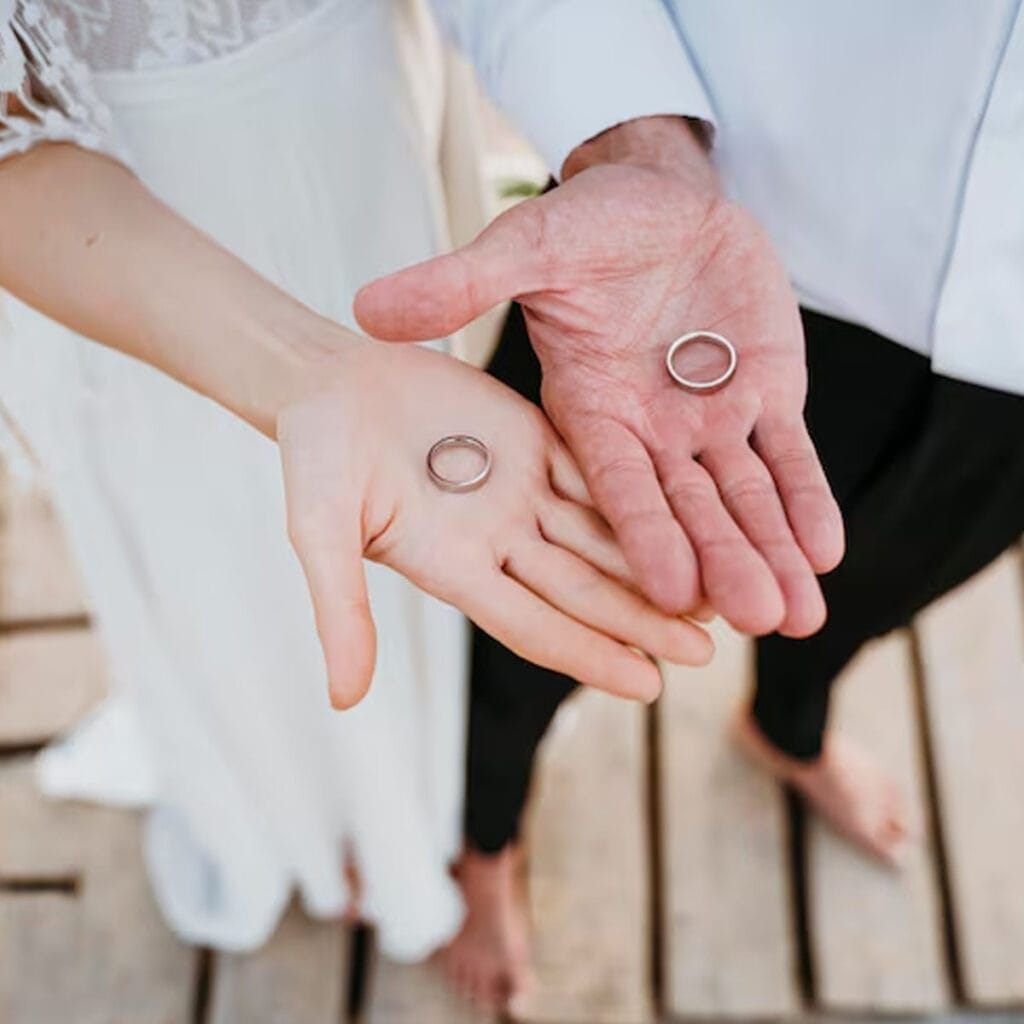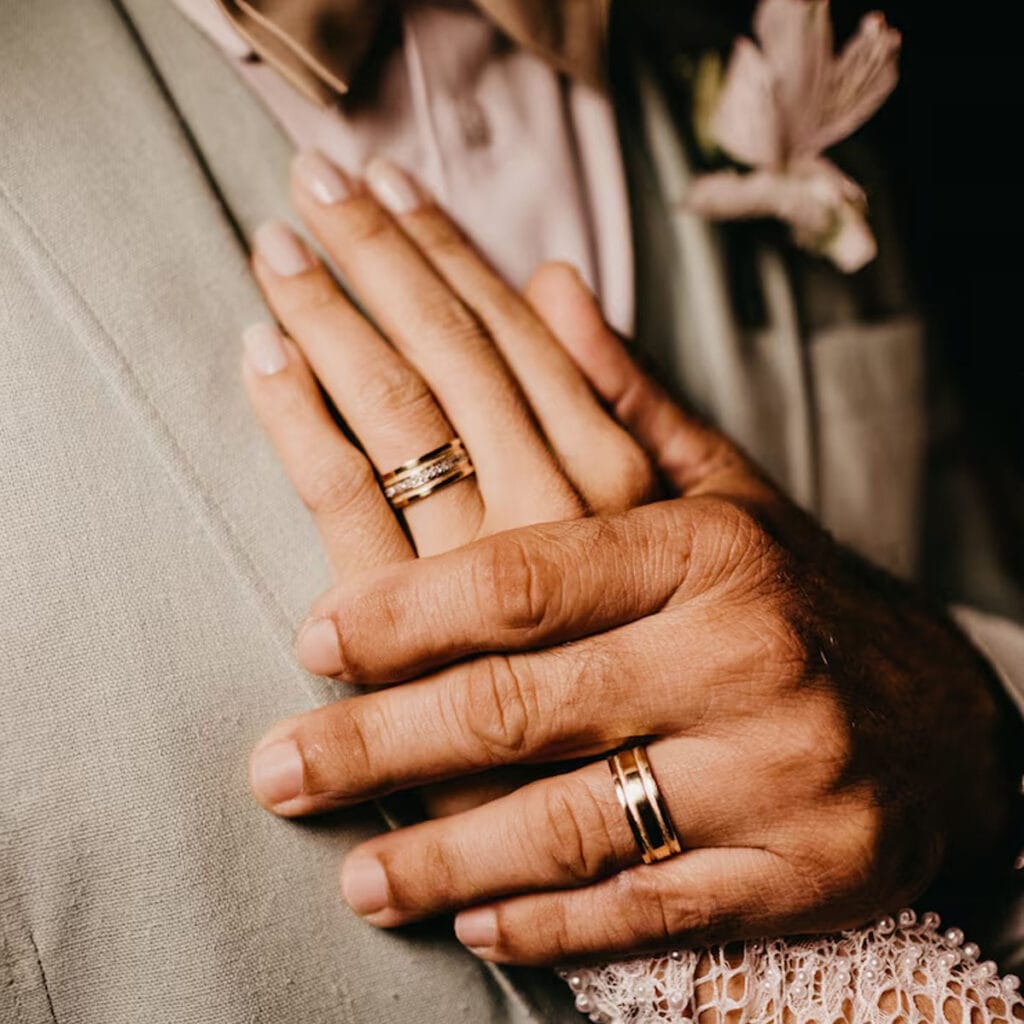Choosing a wedding ring is not merely ticking an item off a planning checklist. It is an intimate ritual that asks two people to weigh history against modern life, sentiment against practicality, and personal taste against centuries‑old symbolism. From the moment the jeweller lifts a tray lined with gleaming circles, each band seems to whisper a story of vows murmured in candle‑lit chapels, of hands entwined on commuter trains, of anniversaries yet to be imagined. Before budgets, metals or widths enter the conversation, couples first sense the quiet gravity of what this small object will witness. This guide begins by honouring that emotional weight, then moves step by step through every technical decision that shapes the ring you will wear long after the confetti is swept away.
Why Rings Speak Louder Than Words
Long before hashtags or marriage certificates, rings communicated fidelity in a language everyone understood. A circle, with neither beginning nor end, conveys permanence more powerfully than any written promise. Anthropologists point to ancient burials where loops of bone or carved shell rested beside two bodies, implying a bond that survived even death. Today’s bands echo that message every time they catch the light on a morning commute.
From Egypt to Rome, the First Wedding Bands
Six millennia ago, Egyptians twisted river reeds into circles to symbolise the flow of life and eternity. As civilisations rose and trade routes expanded, those fragile hoops gave way to sturdier materials: leather, bone, ivory and eventually iron.
Fun Fact: In the third century BCE, Romans inscribed iron rings with the words pignus amoris aeterni – a pledge of eternal love – laying the groundwork for modern engraving customs.
Iron’s toughness suited Roman ideals of marital stability, yet they added a poetic flourish by placing the band on the fourth finger. They believed the vena amoris, a vein of love, ran straight to the heart and thus invested that finger with romantic significance. Although anatomy later disproved the vein, the gesture remains one of the most enduring wedding traditions in Western culture.
Proposal and Ceremony Understanding Two Rings
Modern Western practice distinguishes sharply between the engagement ring and the wedding band, though they work in tandem.
- Timing and Meaning
- The engagement ring marks the promise to marry; the wedding band seals that promise during the ceremony.
- Design Language
- Engagement rings usually showcase a central gemstone intended to draw the eye.
- Wedding bands favour understated elegance, sitting close to the heart and quietly protecting their sparkling counterpart.
- How to Wear Them
- Tradition places the wedding band on the finger first so it rests nearer the heart, followed by the engagement ring. Many brides temporarily shift the engagement ring to their right hand during the vows to make the exchange seamless.
Together, they form a visual shorthand: promise fulfilled, covenant ongoing.
Modern Couples Breaking the Matchy Mould
Twentieth‑century jewellers often sold his‑and‑hers rings that mirrored one another in metal, width and polish. Contemporary couples, however, embrace flexibility.
- Matching Bands
- Identical rings still charm those who value a visible sign of unity and prefer a straightforward purchase.
- Individual Statements
- Partners with contrasting tastes or occupational needs choose entirely different styles. A chef might select a robust, plain band while their partner opts for a slender diamond wedding band. Individuality here honours the notion that marriage combines complementary strengths rather than erasing difference.
- Co‑ordinated Compromise
- Many pairs split the difference, sharing a metal or engraving while varying width or texture. This approach acknowledges personal style yet preserves a discreet aesthetic link.
Some even streamline jewellery by wearing a single band that doubles as both engagement and wedding ring, proving that symbolism adapts as lives and values change. The key is authenticity: the ring should feel true to the wearer as much on an ordinary Tuesday as on the wedding day itself.
Choosing Your Forever Metal
Few decisions affect a ring’s longevity more than the choice of metal. In the United Kingdom, two families dominate fine jewellery: platinum wedding rings and the three colour variations of gold.
Platinum
Naturally bright and silvery-white, platinum resists tarnish and is suitable for sensitive skin. Because scratches shift metal rather than remove it, the surface develops a soft patina rather than thinning over time. Its density gives reassuring weight that many couples associate with permanence.
Yellow, White and Rose Gold
Gold is graded by purity. 18ct gold (75% pure) offers a rich hue, excellent corrosion resistance, and enough softness for engravers to cut deep, lasting lines. 9ct gold (37.5 per cent pure) is harder yet more brittle, so claws on stone settings may crack after decades of wear. White gold needs periodic rhodium plating to keep its cool tone, while rose gold’s copper content creates a warm blush and hardy surface.
Fun Fact: Palladium, once a budget alternative to platinum, shot past it in price when car manufacturers increased demand for catalytic converters.
Matching Metals Matters
Wearing a harder band against a softer engagement ring will erode the latter. Whenever possible, match metals so both pieces age at the same pace.
Profiles and Comfort
The cross‑section, known as the profile, dictates feel as much as style.
- Court – rounded inside and out, famed for comfort on swollen fingers.
- D‑shape – flat inner wall hugged by a domed outer curve for traditional appearance with firmer fit.
- Flat court – sleek modern face with curved interior, a popular best‑of‑both.
- Flat – architectural slab sides, bold yet harsher on the hand in wide widths.
Width matters too: women often favour 2 to 4 mm, men 5 to 7 mm. Increase ring size slightly for widths above 5 mm so the band glides over the knuckle.


Plain Bands or Diamond Sparkle
A pristine metal circle epitomises simplicity: low maintenance, snag‑free and budget-friendly. By contrast, a diamond eternity ring brings scintillation that mirrors the engagement stone.
- Full eternity – stones encircle the finger and cannot be resized.
- Half eternity – gems span the visible upper arc yet leave plain metal beneath, allowing future adjustment.
- Channel, bezel or flush settings protect stones for daily wear, whereas pavé offers maximum light return with slightly greater care needs.
For active lifestyles, half eternity in a protective setting strikes a balance between beauty and practical resilience.
Getting the Size Right
Accurate ring sizing prevents discomfort and loss.
- Visit a trusted jeweller for calibrated gauges; temperature and time of day affect measurements.
- Wider bands feel tighter, so size up by a quarter to half when exceeding 4 mm.
- Platinum and gold can be altered later, but tungsten and full eternity styles cannot.
Engraving and Personal Detail
Laser technology etches precise fonts, fingerprints or soundwaves. Hand engraving delivers organic depth and the charm of an artisan’s touch. Keep messages under thirty characters for clarity. Popular choices include initials, the wedding date or a brief lyric shared in the first dance.
Proof of Quality
Every precious metal ring above the legal threshold must carry a clear UK hallmark: sponsor’s mark, fineness number and assay office symbol. Look for the leopard’s head, anchor, castle or rose to confirm independent testing and protect your investment.
Budget Planning and Smart Spend
British couples spend roughly £950 on two bands, yet value lies in durability rather than price alone. If funds are limited, prioritise metal quality over additional diamonds. Lab‑grown stones reduce cost by about a third while matching mined brilliance.
Timing Your Purchase
Begin researching three to six months before the ceremony. Allow:
- One month for off‑the‑shelf bands plus engraving
- up to three months for bespoke designs or shaped bands
- two extra weeks for final sizing and a professional polish
Having the rings ready a full month ahead removes last‑minute stress.
Keeping the Shine
Clean platinum and gold in warm water with mild washing‑up liquid, gently brushing with a soft baby toothbrush. Rinse over a strainer, pat dry with a microfibre cloth, and book an annual jeweller’s inspection to tighten settings. Remove rings when lifting weights, mixing bleach or swimming in chlorinated pools.
Conclusion
A wedding ring spends more time on your hand than any other possession, silently recording the ordinary hours that make a marriage extraordinary. Choose metal that withstands life’s knocks, a profile that feels like a second skin and a size that adapts with you. Whether you select a plain platinum court or a diamond half‑eternity in rose gold, the band deserves thoughtful care and respect. In the end, it is less about the sparkle and more about the steady glow that accompanies every shared sunrise. As the old saying goes, “Look after the pennies and the pounds will look after themselves.” Treat your rings with the same diligence, and they will repay you in memories far beyond their glittering surface.

